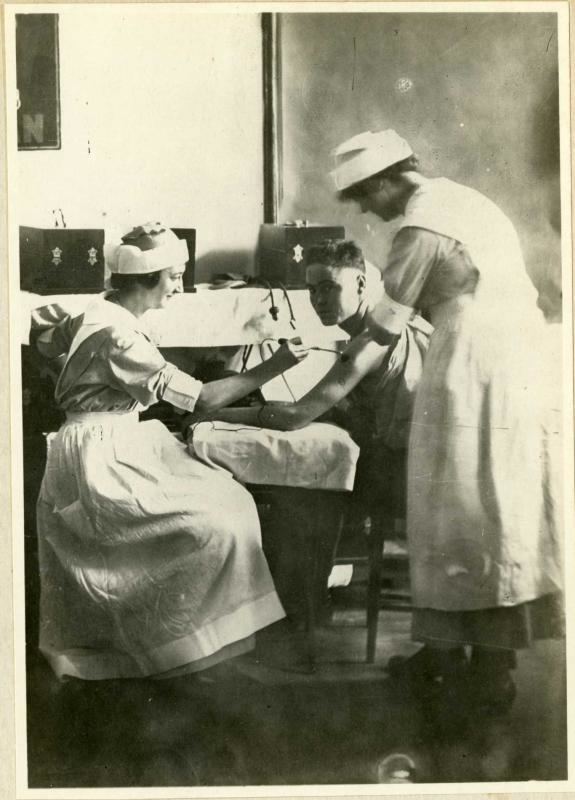MeSH D004599 | ||
 | ||
Electrotherapy is the use of electrical energy as a medical treatment. In medicine, the term electrotherapy can apply to a variety of treatments, including the use of electrical devices such as deep brain stimulators for neurological disease. The term has also been applied specifically to the use of electric current to speed wound healing. Additionally, the term "electrotherapy" or "electromagnetic therapy" has also been applied to a range of alternative medical devices and treatments.
Contents
It has not been found to be effective in increasing bone healing.
History
The first medical treatments with electricity in London have been recorded as far back as 1767 at Middlesex Hospital in London using a special apparatus. The same was purchased for St. Bartholomew's Hospital only ten years later. The record of uses other than being therapeutic is not clear, however Guy's Hospital has a published list of cases from the earlier 1800s.
See also Oudin coils, in use around 1900.
Muscle stimulation
In 1856 Guillaume Duchenne announced that alternating was superior to direct current for electrotherapeutic triggering of muscle contractions. What he called the 'warming affect' of direct currents irritated the skin, since, at voltage strengths needed for muscle contractions, they cause the skin to blister (at the anode) and pit (at the cathode). Furthermore, with DC each contraction required the current to be stopped and restarted. Moreover, alternating current could produce strong muscle contractions regardless of the condition of the muscle, whereas DC-induced contractions were strong if the muscle was strong, and weak if the muscle was weak.
Since that time almost all rehabilitation involving muscle contraction has been done with a symmetrical rectangular biphasic waveform. During the 1940s, however, the U.S. War Department, investigating the application of electrical stimulation not just to retard and prevent atrophy but to restore muscle mass and strength, employed what was termed galvanic exercise on the atrophied hands of patients who had an ulnar nerve lesion from surgery upon a wound. These galvanic exercises employed a monophasic wave form, direct current.
Cancer treatment
In the field of cancer treatment, DC electrotherapy showed promise as early as 1959, when a study published in the journal Science reported total destruction of tumor in 60% of subjects, which was very noteworthy for an initial study. In 1985, the journal Cancer Research published the most remarkable such study, reporting 98% shrinkage of tumor in animal subjects on being treated with DC electrotherapy for only five hours over five days. The mechanism for the effectiveness of DC electrotherapy in treating cancer was suggested in an article published in 1997. The free-radical (unpaired electron) containing active-site of enzyme Ribonucleotide Reductase, RnR—which controls the rate-limiting step in the synthesis of DNA—can be disabled by a stream of passing electrons.
Modern use
Although a 1999 meta-analysis found that electrotherapy could speed the healing of wounds, in 2000 the Dutch Medical Council found that although it was widely used, there was insufficient evidence for its benefits. Since that time, a few publications have emerged that seem to support its efficacy, but data is still scarce.
The use of electrotherapy has been researched and accepted in the field of rehabilitation (electrical muscle stimulation). The American Physical Therapy Association acknowledges the use of Electrotherapy for:
1. Pain management
2. Treatment of neuromuscular dysfunction
3. Improves range of joint mobility
4. Tissue repair
5. Acute and chronic edema
6. Peripheral blood flow
7. Iontophoresis
8. Urine and fecal incontinence
9. Lymphatic Drainage
Electrotherapy is primarily used in physical therapy for relaxation of muscle spasms, prevention and retardation of disuse atrophy, increase of local blood circulation, muscle rehabilitation and re-education electrical muscle stimulation, maintaining and increasing range of motion, management of chronic and intractable pain, post-traumatic acute pain, post surgical acute pain, immediate post-surgical stimulation of muscles to prevent venous thrombosis, wound healing and drug delivery.
Some of the treatment effectiveness mechanisms are little understood, with effectiveness and best practices for their use still anecdotal.
Electrotherapy devices have been studied in the treatment of chronic wounds and pressure ulcers. A 1999 meta-analysis of published trials found some evidence that electrotherapy could speed the healing of such wounds, though it was unclear which devices were most effective and which types of wounds were most likely to benefit. However, a more detailed review by the Cochrane Library found no evidence that electromagnetic therapy, a subset of electrotherapy, was effective in healing pressure ulcers or venous stasis ulcers.
Versus manual therapy
Current research displays that manual therapy is more effective than electrotherapy in the treatment and rehabilitation of orthopedic injuries; with improved pain modulation, improved range of motion and physical function, and communication between patient and clinician. Manual therapy is significantly more effective treating pain, stiffness, and physical function in patients with knee osteoarthritis than electrotherapy. An up-and-coming manual therapy technique called positional-release therapy (PRT) addresses the damaged muscle fibers and puts them in a position to be able to return to normal efficient function. Contrast to PRT many electrotherapy treatments, such as a transcutaneous electrical nerve stimulation (TENS), do not provide any long term changes to the tissue it only addresses the acute pain. Despite the fact that the research states manual therapy is ideal and overall more effective, there are numerous variables involved in determining success rates for treatments.
